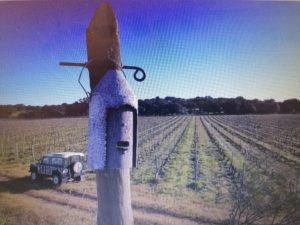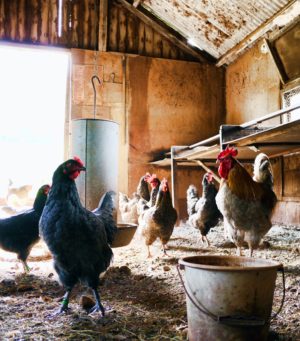A symbiotic relationship between birds and grape growers is emerging, and its implications are vast.
By Kathleen Willcox
Since 1970, bird populations in North America alone have declined by almost 3 billion, according to a study conducted by the Cornell Lab of Ornithology. One of the culprits of this die-off, scientists say, is pesticide. About 1 billion pounds of pesticide is sprayed in the United States each year. Beyond their intended effects, these poisons can contaminate the water and soil and be toxic to a host of organisms, including birds, fish and even humans, according to the EPA.
Many grape growers are finding that they can drastically reduce pesticide use — something many regions are working toward, in a broad push toward more sustainable growing practices — by recruiting wild winged workers.
“Birds and farmers can help each other,” says Matt Johnson, professor of wildlife habitat ecology at Cal Poly Humboldt in Arcata, Calif., who has led several studies on the symbiotic relationship between birds and vineyards. “Our research has focused on owls, primarily, but it has also touched on songbirds like swallows and bluebirds.
“Because so much natural nesting habitat has been destroyed by modern agriculture (including planting vineyards), growers are finding that, by inviting owls and songbirds into their vineyards, it not only helps the birds, but it significantly reduces populations of rodents and insects.”
One of Johnson’s former students, Xerónimo Castañeda, currently the conservation project manager at Audubon California, notes he’s been contending with an influx in requests for information on birds from vineyard managers in recent months.
“The costs of inputs like fuel, and the cost of labor for managing pesticide programs has increased considerably recently,” Castañeda says. “People are starting to realize that, by bringing in birds, they can essentially get free labor — and the hands-off, chemical-free approach benefits everyone.”
Owls + Hawks Terminate Rodents
Rodents have been wreaking havoc on farm fields since the dawn of agriculture. Grape growers are now finding that owls act as more efficient and eco-friendly rodent terminators than pesticides in traps. One family of owls can eat 3,466 rodents per year on average, according to Johnson’s research.
In 2007, Ames Morison, co-founder of Healdsburg’s Medlock Ames, learned what effective allies owls can be when growing grapes organically.
“We set up owl boxes, and the poles where the nest boxes are mounted have a crossbar that attracts red-tailed hawks,” Morison explains. “Both of these birds feed on gophers and voles, which can damage or kill our vines.”
The program has been so successful, the team plans to double its number of owl boxes over the next two years, for a final tally of around 60.

William Thiersch, assistant winemaker and head of sustainability at Ron Rubin, says the team at its 10-acre estate vineyard in Sebastopol, Calif., installed owl boxes in partnership with the Sonoma County Wildlife Rescue program and SIP Certified.
“The four owl boxes we installed in 2016 have been a game changer for our vineyard manager,” Theirsch says. “He used to spend a lot of time, money and effort setting up traps, but the owls take care of our rodents completely. Now he can focus those efforts on farming the grapes.”
Falcons + Eagles Make Great Grape Guards
Some birds are also brought in to act as heavies against smaller birds that feast on grapes.
At Domaine Bousquet in Mendoza, Argentina, peregrine falcons have been brought in to scare away doves that nest in the roof of the winery, as well as grape-eating sparrows, says the winery’s agronomist, Franco Bastias.
“We have perches for day birds of prey, such as eagles, kites and kestrels, to target starlings and other flying vertebrates that wreak havoc on grapes,” says oenologist Luis Duarte of Alentejo, Portugal’s Herdade dos Grous. “By reducing the damage caused by starlings to the grapes, the potential for cryptogamous diseases, such as gray rot, is reduced.”

At Herdade de Coelheiros in Alentejo, agricultural manager João Raposeira, says recruiting winged laborers is a part of the winery’s overall push toward balance and sustainability.
“Having eagles and falcons in the vineyard creates a deterrent to smaller birds that can cause significant damage to crops,” Raposeira says. “From our point of view, any significant damage to fruit and crops caused by birds or insects is indicative of an imbalance. Birds are part of the ecosystem. Our goal is to interpret these systems and enhance their balance and resilience through natural means.”
Spray Reduction
Encouraging natural resilience, and reducing the need to spray pesticides, is at the root of many vineyard bird programs.
In Italy, Trentodoc’s Endrizzi vineyards are farmed organically and “insect-eating birds are asked for help,” says CEO Christine Endrici. “Our 20 nest boxes per hectare make the vineyards a sought-after habitat for chickadees, redstarts, sparrows, robins, hoopoes and bats, who say ‘thanks’ for the hospitality by dependably combating pests like grapevine moths and the leafhopper.”
Other producers, including Ken Forrester Wines in Raithyby, South Africa, also find that having a range of birds helping out in the vines lets them seriously curtail spray programs.

“We use ducks to control snails and insects, and we have raptor poles and owl boxes for rodents,” says winemaker Ken Forrester. “We also use chickens to combat fly maggots.” In addition to the “working birds,” the property is also homes to native wildlife, including “dogs, geese, jackals, otters, porcupine, grysbokke, duikers, owls and other assorted birds.”
The “more is better” philosophy rules the day at Domaine Bousquet as well. “We encourage all fauna by saving rainwater and dispersing it in the vineyard as watering stations for foxes, wild rabbits and birds,” Bastias says. “We now have a healthy population of all kinds of flora and fauna, including endangered [species] that can bring unexpected benefits.”
Several ducks, Bastias explains, have made the winery pond their home, and “Their presence balances the vegetative growth in the pond, and keeps it in balance.”
We’ve seen the unintended, largely negative, consequences of industrial farming and monoculture in vineyards. It’s refreshing to see more and more growers enjoying the flip side.
____________________________________________________

Kathleen Willcox
Kathleen Willcox writes about wine, food and culture from her home in Saratoga Springs, N.Y. She is keenly interested in sustainability issues, and the business of making ethical drinks and food. Her work appears regularly in Wine Searcher, Wine Enthusiast, Liquor.com and many other publications. Kathleen also co-authored a book called Hudson Valley Wine: A History of Taste & Terroir, which was published in 2017. Follow her wine explorations on Instagram at @kathleenwillcox




